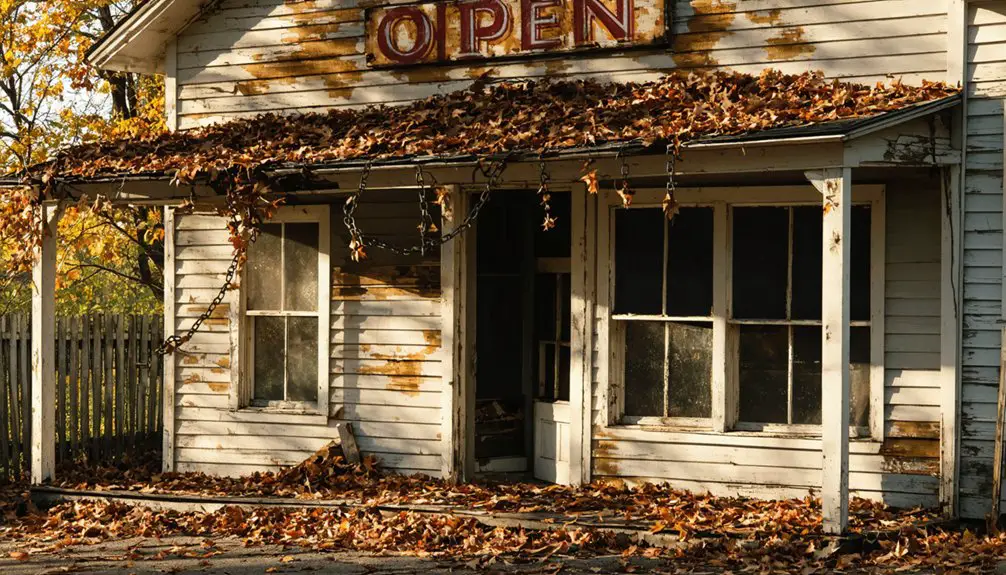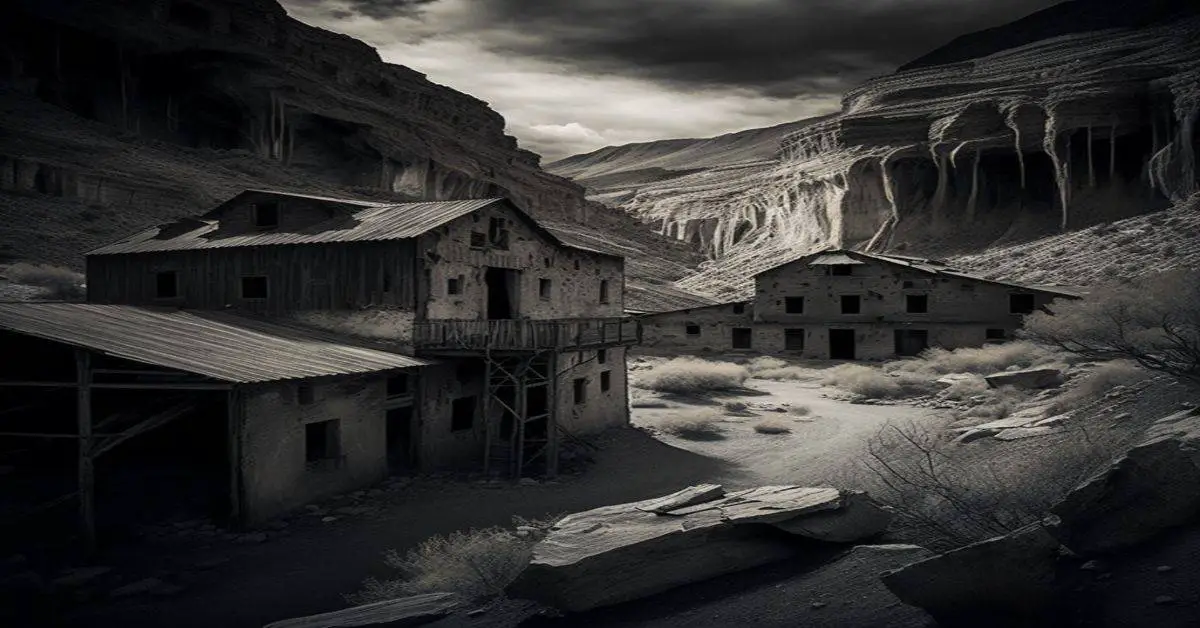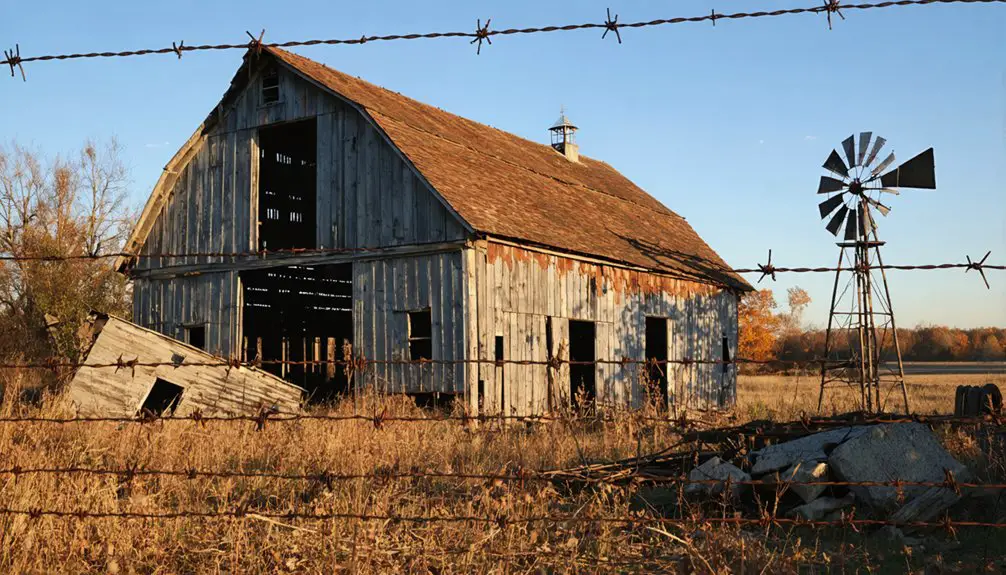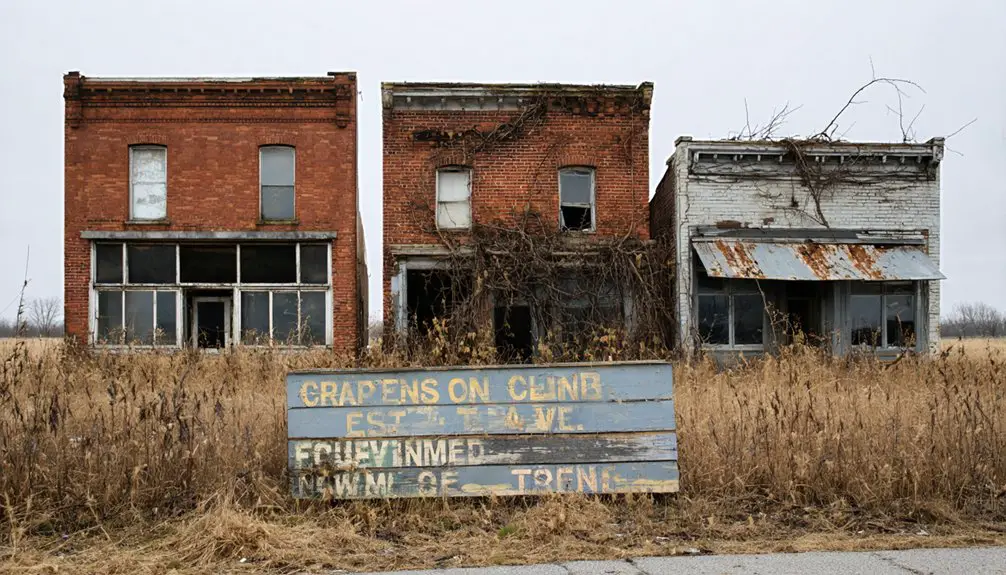You’ll find Elk Lick, Ohio‘s remains beneath East Fork Lake’s waters today. Founded in 1802 by Reverend John Collins and his wife Sarah, this pioneer settlement once thrived around natural salt licks that drew wildlife and settlers alike. The town featured Collins Chapel, a 37-room mansion, and the historic Bethel Methodist Church before the Harsha Lake Project submerged it in 1979. While the buildings are gone, preserved cemeteries and landmarks still tell fascinating tales of this lost community.
Key Takeaways
- Elk Lick, established in 1802, became a ghost town when the Harsha Lake Project submerged the historic community under East Fork State Park.
- The town was founded by Reverend John Collins and named for natural salt licks that attracted wildlife and early settlers.
- Most original structures, including historic homes and buildings, were relocated or demolished during the 1979 lake construction project.
- Only cemeteries remain as physical evidence of Elk Lick’s existence, including the Early Settlers Burying Ground and Old Bethel Methodist Cemetery.
- The town’s 2,160 acres were transformed into a reservoir, forcing residents to relocate and ending the community’s 177-year history.
The Birth of a Pioneer Settlement
When Reverend John Collins and his wife Sarah Blackman Collins founded Elk Lick in 1802, they established what would become an essential pioneer settlement in Ohio’s Tate Township.
You’ll find the town’s origins deeply rooted in the area’s natural salt licks, which attracted both wildlife and settlers seeking to build their lives on the frontier.
As you explore the settlement’s early dynamics, you’ll discover how the Collinses tackled pioneer challenges by first building a log cabin church in 1805, known as Collin’s Chapel. The church and its surrounding structures featured natural springs nearby, similar to those that supported the growth of Charleston.
This spiritual cornerstone of the community evolved into the Bethel Methodist Church by 1818, when they upgraded to a wood frame structure.
The settlement’s strategic location near the East Fork Little Miami River and Stonelick Creek provided vital water resources, while ancient trails connected settlers to the broader frontier landscape. The area gained renewed attention in 1868 when Samuel Atchley discovered gold along Karin’s Run near the East Fork of the Little Miami River.
Natural Features That Shaped the Town
The name “Elk Lick” reflects the defining natural feature that drew both settlers and wildlife to this frontier location – a mineral-rich salt lick that provided crucial nutrients for elk, deer, and other animals. This geological formation shaped not just the town’s name but its entire ecosystem.
You’ll find the landscape was dramatically sculpted by ancient glaciers, creating steep ravines and rocky cascades that influenced where people could build and farm.
The area’s mineral resources extended beyond the salt lick, with varied soil chemistry supporting diverse plant communities. From beech-maple forests on the hills to swamp forests in the lowlands, the rich mix of habitats sustained wildlife and provided settlers with crucial materials. The terrain’s natural features now provide ideal conditions for vast trail systems that wind through the historical grounds.
Nearby creeks, shaped by glacial deposits, offered water power and transportation routes essential to the settlement’s growth. Today, much of the original town lies submerged under East Fork State Park, with only its church and cemetery remaining visible to visitors.
The Collins Family Legacy
John Collins, a Quaker-born Methodist minister from New Jersey, established Elk Lick’s foundation in 1802 by purchasing 300 acres in the fertile Ohio valley.
The Collins Family’s economic influence shaped the region through strategic land ownership and architectural development, including stone houses with distinctive features. Around 1805, John Collins constructed a two-story stone residence that would become a cornerstone of the settlement. The area was named for the abundant natural salt licks that attracted wildlife to the region.
The family’s lasting impact reflected in these key developments:
- Construction of prominent residences overlooking the East Fork of Miami River
- Support of local institutions like the one-room schoolhouse
- Establishment of Methodist religious culture through Old Bethel Cemetery
- Political aspirations to relocate the county seat to Elk Lick
Though their original structures largely disappeared during the 1970s East Fork Lake development, the Collins Family legacy endures through the preserved Old Bethel Methodist Cemetery, where John and Sarah Collins rest.
Religious and Cultural Foundations
Religious conviction formed the bedrock of Elk Lick’s identity from its earliest days, beginning with Reverend John Collins’s establishment of Collins Chapel in 1805.
Faith shaped Elk Lick from its foundation, starting when Reverend Collins built the town’s first chapel in 1805.
You’ll find that Methodist influence dominated the town’s spiritual landscape, particularly after Collins Chapel was replaced by Bethel Methodist Church in 1818.
The church wasn’t just a place of worship – it served as the heart of community gatherings and social events. Religious practices shaped everything from daily life to major celebrations, with the church grounds hosting weddings, funerals, and holiday festivities. Before the town was submerged by the creation of Harsha Lake, residents gathered frequently at these sacred grounds.
You can still visit Bethel Methodist Church today, as it stands as a National Historic Place since 1978, while the adjacent Early Settlers Burying Ground preserves the memory of Elk Lick’s pioneers and veterans through its historic markers.
Notable Architecture and Landmarks
The grandeur of Elk Lick’s architecture was epitomized by Richard Collins’ 37-room mansion, which stood as Clermont County’s most prominent residence for decades before its ultimate destruction.
You’ll find traces of the town’s religious heritage in Bethel Methodist Church, built in 1867 on the site of John Collins’ original 1805 log cabin church and now listed on the National Register of Historic Places.
The area’s pioneer spirit lives on through the Early Settlers Burying Ground, where stone monuments commemorate the town’s first residents, including the mysterious Unknown Hunter believed to be the cemetery’s first burial. The historic Elk Lick House, a modest two-room cottage built in 1818, was once home to abolitionist Thomas Morris before being relocated to Heritage Village Museum.
Bethel Methodist Church Legacy
Founded in 1805 as a humble log cabin known as Collins Meeting House, Bethel Methodist Church grew to become a cornerstone of religious life in Elk Lick, Ohio. Under Reverend John Collins’ leadership, this Methodist influence shaped the region’s spiritual development through powerful revivals and regular prayer meetings. The church held regular class meetings under the guidance of Rev. Levi White, fostering strong community bonds. The building sits within East Fork State Park, offering a peaceful setting for visitors to explore its rich history.
You’ll discover the church’s enduring legacy through these significant aspects:
- The original 1818 frame church featured a distinctive high pulpit and three-sided galleries.
- The current 1867 structure maintains vernacular design with weatherboard walls and a prominent square belfry.
- The surrounding cemetery contains graves of U.S. President Grant’s grandparents.
- Its National Register of Historic Places listing in 1978 recognizes both architectural and historical significance.
Today, it stands as one of the last remaining landmarks of the former Elk Lick community.
Collins Mansion Grandeur
Standing as a proof of pioneer ambition, the Collins Mansion emerged in the early 1800s through the vision of Methodist minister John Collins, who purchased 300 acres near Elk Lick after relocating from Gloucester County, New Jersey.
The mansion’s unique architecture blended frontier practicality with status symbolism, featuring a two-story stone construction that set it apart from typical wooden structures of the time. You’ll notice its distinctive elements included a massive interior-end chimney and narrow frieze boards that simulated cornice returns.
The Collins family’s influence extended beyond their remarkable residence, as they helped shape Elk Lick into an affluent early 19th-century Ohio community.
Though demolished in 1972 for the East Fork Lake project, the mansion’s legacy lives on as a monument to the architectural ambition of Ohio’s pioneer period.
Salt Lick Pioneer Buildings
Located along Salt Lick Creek, pioneer buildings of Salt Lick Town emerged in 1795 around Ohio’s first major salt production industry. The settlement’s structures reflected simple yet functional pioneer architecture, built primarily from local timber to support the thriving salt works.
You’ll find these fascinating remnants of early American industry:
- Salt processing facilities with boiling vats and storage areas
- The Old Bethel Methodist Church and cemetery, which operated until 1972
- Mills, general stores, and cooper factories that supported the salt trade
- Pioneer homes including the preserved Thomas Morris house, built in 1818
The community’s buildings centered around salt licks that attracted wildlife and settlers alike.
While many structures were demolished in the 1970s for East Fork Harsha Lake, some historic buildings found new life in the Heritage Village Museum.
Life in Early Elk Lick
As early settlers carved out their existence in Elk Lick township during the late 1780s, they found themselves drawn to the area’s abundant natural resources and strategic waterways.
You’d have witnessed pioneer agriculture taking root, with Joseph Markley’s farm leading the way near Pine Run and Casselman River. Early industries emerged around the region’s natural salt spring, while hunting and trapping sustained many families.
If you’d lived there, you’d have shared the land with indigenous peoples, particularly the Adena, whose burial mounds still marked the landscape.
Your daily life would’ve centered on farming, but the discovery of coal, iron ore, and limestone deposits soon transformed the economy.
You’d have watched as isolated farmsteads gradually gave way to more structured communities, complete with basic schools and stores.
The Harsha Lake Project’s Impact
You’ll find that the Harsha Lake project‘s construction in 1979 required the displacement of Elk Lick‘s remaining residents and structures, marking the end of the historic community’s physical presence.
The creation of the 2,160-acre reservoir faced engineering challenges related to soil composition and watershed management during the dam’s construction on the East Fork Little Miami River.
The U.S. Army Corps of Engineers coordinated with local authorities to guarantee proper relocation of community members while managing the technical aspects of transforming the valley into what would become an essential flood control system.
Community Displacement Timeline
Before the completion of William H. Harsha Lake in 1979, the displacement dynamics of Elk Lick unfolded through a series of calculated government actions.
You’ll find that community resilience was tested as residents faced the inevitability of relocation during the 1960s and early 1970s.
The timeline of displacement proceeded through these key phases:
- Initial land acquisition surveys and property assessments began in the 1960s
- Federal compensation negotiations with property owners followed standard protocols
- Mandatory relocations accelerated through the mid-1970s
- Final exodus completed before the 733-foot water level rise in 1979
The process transformed 2,160 acres into what you now know as Harsha Lake, permanently submerging the once-vibrant mining community beneath its waters.
Lake Construction Challenges
When construction began on William H. Harsha Lake in July 1971, you would’ve witnessed significant construction hurdles and environmental compliance challenges that shaped the project’s trajectory.
The Army Corps of Engineers faced multiple lawsuits, including one from Ohio state officials, while grappling with NEPA requirements and environmental impact concerns.
You’ll find the technical challenges were equally formidable. The project required clearing 12,000 acres of prime farmland and disrupting natural drainage patterns, which complicated sewer planning.
Local county commissioners expressed concerns about federal responsibility for these impacts. Water quality issues emerged as agricultural runoff contributed to 70% of nitrogen and phosphorus loading, leading to harmful algal blooms.
The Corps initiated algae harvesting technology and constructed off-channel wetlands to combat these persistent environmental challenges.
Preserved Memories in Local Cemeteries
Though Elk Lick itself vanished beneath the waters of East Fork Lake in 1972, its cemeteries stand as enduring monuments to the town’s legacy.
You’ll find these historic burial grounds preserved on elevated land within East Fork State Park, their cemetery preservation ensuring that the stories of early pioneers aren’t lost to time.
The historical significance of these sacred grounds is evident through:
- The Early Settlers Burying Ground, donated by pioneers Obediah and Mary Denham
- Military veterans’ graves spanning from the Revolutionary War to modern times
- The Collins family plot, including town founder John Collins and War of 1812 veteran Richard Collins
- A stone marker commemorating the “Unknown Hunter,” believed to be the area’s first burial
These carefully maintained sites serve as your gateway to understanding Elk Lick’s rich heritage and the individuals who shaped its destiny.
Modern Historical Research and Documentation
Despite being submerged beneath East Fork Lake, Elk Lick’s rich history lives on through extensive modern research and documentation efforts.
You’ll find the town’s legacy preserved through archival research at Heritage Village Museum, where the historic Elk Lick House stands as a symbol of its political significance and abolitionist roots.
Community narratives have been carefully reconstructed using multiple documentation sources, from cemetery records to architectural surveys.
Through careful historical detective work, researchers pieced together Elk Lick’s story using everything from gravestone inscriptions to building records.
The stories of prominent families like the Collins and Elstuns emerge through preserved documents, while the town’s evolution from its 1802 founding through the railway era remains traceable through maps and structural records.
The site’s transformation during the Harsha Lake Project has been thoroughly documented, allowing you to understand how this once-thriving community adapted to change over time.
Frequently Asked Questions
What Happened to the Remains of Buildings Not Relocated Before Flooding?
You’d be surprised to learn that building remnants weren’t preserved – they’re now permanently submerged underwater. Most structures were deliberately demolished before flooding, while those left standing disappeared beneath the lake’s surface.
How Many Families Were Displaced During the Harsha Lake Construction?
You won’t find exact numbers of displaced families in official records, though family stories suggest the displacement impact spread across 10,000+ acres of previously inhabited Clermont County land.
Were There Any Major Epidemics or Disasters Before the Town’s Flooding?
Like a blazing inferno from hell, you’ll find no major epidemic history, but two devastating arsons rocked the town – the school in 1931 and another disaster on Halloween 1936 – before flooding.
What Industries or Businesses Operated in Elk Lick Before Its Decline?
You’d find small general stores, farming operations, cooperage shops for barrel making, and a post office thriving there. Though salt production and timber industry potential existed, they weren’t greatly developed.
Did Native American Tribes Have Settlements Near Elk Lick’s Salt Licks?
You’ll find evidence that Native Americans, including Shawnee, Delaware, and Wyandotte tribes, established settlements near these salt licks, using them strategically for hunting, trade routes, and essential resources.
References
- https://www.youtube.com/watch?v=q-_mnf-hp7A
- https://tatetownship.org/2023/04/23/ohioghosttowns-org-contains-tate-township-history/
- http://ohiohistoricarchitecture.blogspot.com/2018/02/clermont-countys-collins-farm.html
- https://ohioghosttowns.org/carroll-county/
- https://ohioghosttowns.org/clermont-county/
- https://www.lickingtwplc.gov/documents/history/HistoryOfLickingTownship.pdf
- https://bataviatownship.org/history.html
- https://heritagevillagecincinnati.org/wp-content/uploads/2023/03/Elk-Lick-House-Handbook-Narrative.doc
- https://ohiodnr.gov/go-and-do/plan-a-visit/find-a-property/east-fork-state-park
- https://kids.kiddle.co/Elk_Lick



